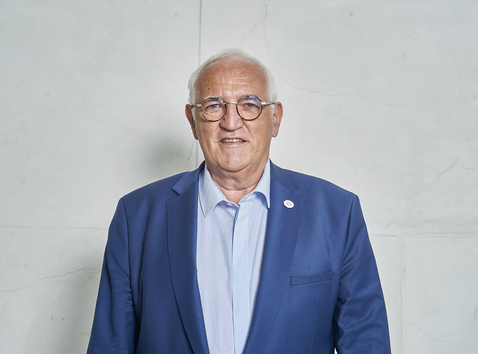Energy
Fusion Energy: Technologies Driving Europe’s Reindustrialization

Superconductors, Cryogenics and Liquid Metals: Beyond Fusion, These Technologies Are Accelerating Industrial Innovation in Europe
This article has been translated using artificial intelligence
This article is part of a series by Fundación Innovación Bankinter aimed at bringing fusion energy closer to society, while highlighting the people, technologies, opportunities, and challenges shaping the future of this clean, safe, and virtually limitless energy source.
At a pivotal moment for fusion -with unprecedented scientific breakthroughs and a steadily growing industrial ecosystem- the Foundation gathered global leaders in Madrid to debate its feasibility and potential. Under the title “Fusion Forward“, the Future Trends Forum brought together a diverse and influential group: from pioneering scientists and international regulators to engineers, tech startups, and venture capital funds. The goal: to explore not just when fusion will reach the grid, but how this energy revolution is already creating value.
In this context, two standout contributions offered a strategic, industry-driven perspective:
Diego Cammarano, Chief Operating Officer at Renaissance Fusion (France), and Frédéric Bordry, Chief Technology Officer at Gauss Fusion (Germany) and former Director of Accelerators at CERN.
Rather than focusing solely on plasma confinement or ignition challenges, both speakers emphasized the enabling technologies behind fusion –superconductors, cryogenics, and liquid metals– and their massive potential to be transferred into other key industrial sectors.
Their perspectives are complementary and deeply aligned:
On one side, Renaissance Fusion showcases the agility of a startup innovating in magnet fabrication and liquid wall systems.
On the other, Gauss Fusion brings a systems engineering mindset and lifecycle approach to scale those innovations.
Both converge on a powerful message:
Fusion is not just an energy promise -it’s a technological lever to reindustrialize Europe and transform strategic industries.
🎥 Watch Diego Cammarano’s talk here:
🎥 Watch Frédéric Bordry’s talk here:
Spillover Technologies: A Quiet Engine of Innovation
In the emerging ecosystem of nuclear fusion, spillover technologies are quickly becoming one of the most promising drivers to attract investment, deliver immediate industrial value, and build supply chains with a ripple effect across multiple sectors. These derivative technologies -born from the development of components and processes for future fusion machines- are already finding real-world applications in fields like healthcare, energy, transportation, and advanced manufacturing.
The concept isn’t new, but it has gained strong momentum recently for three key reasons:
- The maturation of specific subsystems in both labs and startups,
- Investor pressure to generate returns ahead of fusion energy commercialization,
- The growing institutional support for public-private partnerships aimed at accelerating the sector’s economic impact.
At the Future Trends Forum, this vision was strongly advocated by leaders from startups like Renaissance Fusion and Gauss Fusion, who emphasized that many of the technologies required to operate a full-scale fusion reactor –superconductors, cryogenics, liquid metal loops, power electronics, or remote maintenance robotics- have stand-alone value beyond the ultimate energy goal.
According to the IAEA’s 2024 report Fusion Key Elements, there is a growing global convergence between public and private programs toward joint roadmaps that explicitly prioritize the development of industrial capabilities around these enabling technologies. The report stresses that reaching ignition or Q > 1 is not enough; what’s also needed is building value chains, training talent, and fostering market confidence.
In parallel, the 2024 Global Fusion Industry Report notes a sharp increase in public capital flowing into private fusion companies -from $271M to $426M in a single year. A key driver of this growth is the recognition that spillover technologies can accelerate both the technological maturity and profitability of these companies.
In fact, more and more firms are reframing their narrative. They are no longer presenting themselves solely as “fusion machine developers,” but rather as technology platforms capable of creating value across multiple strategic industries. This shift has important implications: it helps attract talent, generates revenue streams ahead of grid fusion, and showcases execution capacity to both regulators and investors.
In short, spillover technologies are no longer just a positive side effect –they are becoming a core industrial strategy within the nuclear fusion ecosystem. And they’re doing so at the right moment, as the industry is under pressure to deliver tangible results beyond confinement curves and plasma simulations.
The Superconductor Revolution
High-temperature superconductors (HTS) are poised to play a key role in the next generation of fusion machines but their impact extends far beyond the energy sector. They are at the core of a technological revolution with immediate applications across multiple industries: from advanced medical diagnostics (MRI) to electric aircraft engines, compact wind turbines, particle accelerators, and the power grids of the future.
In fusion, HTS materials enable the generation of stronger and more compact magnetic fields. This translates into smaller, more efficient, and more cost-effective reactors. Yet one of the main bottlenecks has been the difficulty of fabricating complex magnets with the geometric precision and reliability required to withstand extreme conditions.
That’s where Renaissance Fusion’s approach represents a paradigm shift. As COO Diego Cammarano explained, the company has developed a proprietary process for producing wide HTS tapes using physical vapor deposition (PVD) and laser etching. This method allows them to “paint” superconducting paths on an HTS surface with micron-level precision, eliminating the need for complex 3D coil winding on unconventional geometries.
Beyond drastically reducing manufacturing complexity and cost, this breakthrough enables a new magnet architecture for compact stellarators. Instead of relying on discrete coils, Renaissance Fusion creates continuous conductive surfaces –what they call “superconducting carpets.” These can be applied directly to the outside of the vacuum chamber, simplifying assembly and improving magnetic performance.
But the implications go far beyond fusion. These techniques open the door to a new generation of magnets for industrial use. Medical device companies, cable manufacturers, particle physics labs, and electric generator producers are already in talks with Renaissance Fusion to adapt the technology to their needs. According to the company, they are currently collaborating with three HTS cable manufacturers, a global cryogenics company, a European MRI manufacturer, and a synchrotron facility, among others.
The HTS case also highlights a strategic challenge for Europe: the urgent need to establish domestic production capacity for HTS tapes. As Frédéric Bordry points out, the lack of a European industry capable of manufacturing these materials at scale represents a critical vulnerability. “We cannot depend solely on external supply chains if Europe wants to lead the next generation of energy and medical technologies,” he warns.
Bordry draws a parallel with the role of the Tevatron at Fermilab, which in the 1980s catalyzed the industrial development of niobium-titanium (NbTi). He suggests that fusion could do the same for HTS materials. “MRI and NMR technologies exist today thanks to particle physics. Fusion could have a similar multiplier effect -if we play our cards right.”
But to make that happen, good ideas are not enough. What’s needed is coordinated investment, open testing platforms, collaboration between startups and large companies, and a regulatory framework that recognizes superconductivity as a critical technology for Europe’s energy, medical, and scientific sovereignty.
Bordry: From Tevatron to MRI, Cryogenics, and Building Value Chains
The history of fusion is deeply intertwined with the evolution of technologies that have become essential across many industries. One of the most authoritative voices in tracing this lineage is Frédéric Bordry. In his talk, he offered a sharp and insightful overview of how fundamental research in particle physics has long served as a powerful driver of technological innovation with far-reaching industrial and social impact.
Bordry recalled how the Tevatron at Fermilab, activated in 1983, was the first particle accelerator to use large-scale superconducting magnets (4.4 Tesla, 100 tons of niobium-titanium). This breakthrough was not only critical for high-energy physics but also created a domino effect in other sectors, especially healthcare. “The Tevatron was the grandfather of all superconducting projects. Without it, MRI as we know it wouldn’t exist,” he stated.
Simultaneously, fusion experiments in Europe -such as the Tore Supra tokamak (now WEST)- also adopted niobium-titanium and pushed innovation in cryogenics, especially through the use of superfluid helium at 1.8 K, a technology that later became essential for the LHC at CERN. These developments helped build a value chain around superconducting magnets and cryogenics that now forms part of Europe’s critical scientific infrastructure.
Today, the challenge is to replicate that success -this time around high-temperature superconductors (HTS), which enable stronger magnetic fields and higher operational temperatures.
From his new role at Gauss Fusion, Bordry advocates for a fully industrial vision of fusion: it’s not just about building a working reactor, but about designing a replicable, maintainable architecture that can operate for 40+ years, supported by robust supply chains, modular components, and systems accessible for remote maintenance. This demands that systems engineering, power converters, cryogenics, and magnet technologies be integrated from the outset into a long-term operational framework.
One of Gauss Fusion’s strategic lines is the development of removable magnets with superconducting connectors –a solution that, while not enabling instant swaps, allows for planned and efficient maintenance interventions. This approach improves reactor operability and can also be applied in other industries where access and modularity are critical.
Ultimately, Bordry’s vision goes beyond fusion. For him, true success lies in ensuring that the technologies developed to contain plasma and withstand extreme conditions fuel a competitive European industrial ecosystem –one that exports not only energy solutions, but also medical, aerospace, and critical infrastructure technologies.
“Fusion is the perfect excuse to push the state of the art in multiple key technologies. But if we don’t start building the value chain now, we’ll be late… again,” he concluded.
Liquid Metals: Beyond Plasma Containment
If superconductors are the muscles of a fusion reactor, liquid metals promise to be its skin –a living, dynamic, functional layer that shields solid structures, absorbs neutrons, breeds tritium, and potentially contributes to thermal conversion. While the use of liquid metals in nuclear environments isn’t new -pioneering experiments date back to the 1990s, such as the APEX project in the U.S.- their revival as an integrated solution in fusion reactors signals a new stage of technological maturity.
Renaissance Fusion has placed this technology at the core of its approach. In his talk in Madrid, Diego Cammarano presented how the company has successfully levitated a 10 cm layer of galinstan (an alloy of gallium, indium, and tin) inside a one-meter-wide experimental chamber. This experimental milestone demonstrates the feasibility of maintaining a stable liquid metal surface in direct contact with plasma –without physical containers, using magnetic and dynamic equilibrium.
The potential advantages of this approach are multiple:
- Neutron shielding: Liquid metals can absorb high-energy neutrons without structural degradation, unlike solid materials -extending the reactor’s component lifespan.
- Reduced radioactive waste: By preventing structural components from becoming activated by radiation, long-lived radioactive waste is minimized.
- Tritium breeding: Using liquid lithium (especially isotopes like Li-6 and Li-7) enables neutron capture and in-situ tritium production -closing the critical deuterium-tritium fuel cycle.
- Modularity and self-healing: As a fluid surface, liquid metal can self-repair microdamage, preventing catastrophic failures in case of plasma contact.
Beyond galinstan, Renaissance Fusion is also working with enriched lithium and tin, adjusting the metal composition depending on the use case (cooling, shielding, tritium generation). As Cammarano explained, the company is building complete liquid metal loops –with induction pumps, instrumentation systems, acidity control, and isotope separation- that will serve not only their own prototypes but can also be licensed or supplied to other nuclear sector players.
This isn’t just theoretical. Renaissance is already in talks with research centers, national labs, and other fusion startups seeking to integrate liquid metal systems into their designs. In fact, more than 20 companies in the fusion ecosystem currently require liquid lithium or advanced cooling solutions.
But the impact goes far beyond fusion. These same liquid metal loops can be applied to:
- Advanced fission reactors, such as molten salt or heavy metal-cooled designs.
- Thermal management systems in space and defense industries, where heat control under extreme conditions is critical.
- Shielding technologies in particle accelerators and synchrotrons, which require protection from high-intensity particle flux.
As one forum participant noted, the key lies in recovering lessons from projects like APEX and combining that knowledge with current experimental capabilities.
From CERN to Renaissance Fusion: The Circular Story of Technology Transfer
One of the strongest insights emerging from the evolution of fusion technologies is that knowledge doesn’t move in a straight line -it moves in spirals. What’s discovered in one sector can create value in another. What’s invented for a particle physics experiment may one day save lives in a hospital. And what’s developed for a fusion machine can end up fueling new industrial chains well beyond the energy sector.
This circular model of technology transfer is clearly visible in the careers of key players in today’s fusion ecosystem. Both Frédéric Bordry and Diego Cammarano embody this synergy across disciplines.
Bordry, with decades of experience at CERN –where he oversaw some of the most complex systems ever built- now champions a vision at Gauss Fusion in which modular engineering, operational reliability, and lifecycle optimization are integral from the start of reactor design.
Cammarano, meanwhile, leads a deep-tech startup, Renaissance Fusion, that applies advanced industrial principles to create core components designed for use both inside and outside the reactor. Their innovations in superconductors, laser etching, and liquid metals are rooted in decades of basic and applied research at institutions like MIT, CERN, and ITER.
This return on public scientific investment is also why governments and public institutions are beginning to see fusion in a new light. As the 2024 Fusion Industry Association report notes, the sector’s success doesn’t hinge solely on demonstrating electricity generation from plasma -but on turning every intermediate step into an economic opportunity.
And that’s exactly what many of the most promising startups are doing: building labs not just to validate concepts, but also to offer products, license technologies, and form industrial partnerships. Renaissance Fusion, for example, is developing dedicated business lines around superconducting cables, industrial magnets, cryogenics, and liquid metal loops. Each of these is potentially transferable to medicine, aerospace, defense, or conventional nuclear energy.
Another standout example is Kyoto Fusioneering –a company that doesn’t build reactors, but instead positions itself as a supplier of critical components such as gyrotron heating systems, thermal cycles, and D-T fuel technologies. Its modular, exportable model is built precisely on leveraging multi-disciplinary expertise to accelerate commercialization of fusion-adjacent technologies.
This approach is grounded in a key idea: the fusion machine is not just a goal -it’s an ecosystem capable of generating returns long before electricity reaches the grid. Technology transfer is no longer a desirable side effect -it’s a core strategy for economic sustainability and social impact.
In that sense, history comes full circle: from CERN to MRI, from MRI to HTS superconductors, from there to fusion -and now, back to general industry. A virtuous spiral of innovation turning each scientific breakthrough into a multiplier of economic and technological opportunity.
Europe and the Challenge of Technological Sovereignty
The development of fusion energy is not only a scientific and engineering feat—it’s also a strategic test for Europe’s technological autonomy. While the continent has a strong track record in nuclear research -leading initiatives like ITER, JET and W7-X– it now faces growing vulnerabilities in the manufacturing and supply of critical technologies, particularly in high-temperature superconductors (HTS) and advanced cryogenic components.
The risk is not just about losing competitiveness. It’s about being left out of the value chains that will emerge around fusion -just as happened with semiconductors and solar panels. The IAEA’s Fusion Key Elements report (2024) emphasizes this point: without a solid industrial base, shared testing platforms, and coordinated public-private action, the promise of fusion could still be fulfilled -but elsewhere in the world.
Some political and institutional responses are beginning to take shape. Germany’s “Fusion 2040” program is allocating public funding directly to private fusion companies and their tech suppliers. Meanwhile, the European Union is working to establish a dedicated industrial investment consortium before 2026.
But the effort can’t remain solely at the macro level. As shown by Renaissance Fusion and Kyoto Fusioneering, deep-tech SMEs are essential players in the fusion value chain: agile, risk-taking, and cross-disciplinary. Yet these companies need stable environments, access to capital, shared infrastructure, and international visibility.
There is also a cultural barrier that must be addressed. Fusion has long been framed as a purely scientific, long-term, high-risk venture -slowing its industrial momentum. Reframing the narrative to highlight the short- and medium-term economic opportunities of spillover technologies could be key to mobilizing the entire European innovation ecosystem.
Because technological sovereignty is not built solely through mega-projects, but through a robust, distributed network of capabilities, trained talent, and strategic collaboration. And in that arena, Europe still has time—but no room for complacency.
Conclusion: Fusion of Ideas for a Global Industry
For decades, fusion energy has been described as “the energy source of the future.” But what became clear at the Future Trends Forum: Fusion Forward is that its impact is already happening—though not only where we traditionally expected. Fusion is not just an energy promise -it’s an engine of cross-sector innovation with industrial potential.
The spillover technologies emerging from fusion are catalyzing a new generation of solutions in medicine, aviation, critical infrastructure, defense, and advanced manufacturing. The reactor may still be a decade away from plugging into the grid, but the technological revolution making it possible is already creating value.
This shift requires a new mindset: moving beyond seeing fusion as a binary goal (success or failure) and instead embracing it as a platform for industrial innovation. An ecosystem where each breakthrough can lead to exportable products, profitable companies, and skilled jobs.
It also presents a strategic opportunity: if Europe aligns its scientific, industrial, and policy capabilities, it can lead the way in fusion -and use it as a lever for technological sovereignty in key sectors. But that demands a firm commitment: investing not only in flagship reactors, but in intermediate labs, domestic supply chains, and forward-looking public-private partnerships.
As companies like Renaissance Fusion, Gauss Fusion, and Kyoto Fusioneering demonstrate, the path is not just about building “the first working reactor,” but about building a fusion economy –where value is created before, during, and after the plasma.
In the end, it will be the fusion of ideas –between science and industry, public and private, sectors and disciplines-that matters as much as fusion itself.
If this systemic vision takes hold, the sector could deliver clean energy by 2035, industrial innovation by 2025, skilled employment by 2026, and technological sovereignty by 2030.
The fusion era has already begun.
And its greatest contribution may not be measured in megawatts, but in the ideas that are already reshaping global industry.
This article is part of the ongoing analysis by the Fundación Innovación Bankinter. The full report, “Fusion Energy: A Revolution in Progress,” brings together insights from more than 20 international experts and identifies the five critical levers to scale fusion as a climate, economic, and technological driver.
Download it here to explore how we can start building tomorrow’s energy system today.
And if you want to keep following this transformation, don’t miss the next articles in the Fusion Forward series – where we continue to bring the future of energy closer to society, with rigor, foresight, and purpose.







